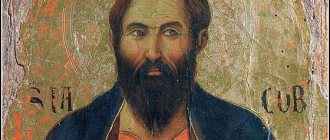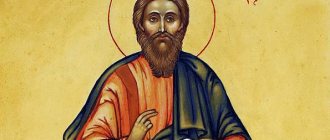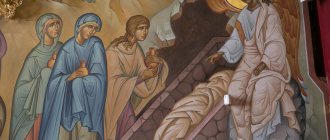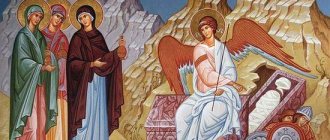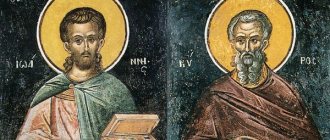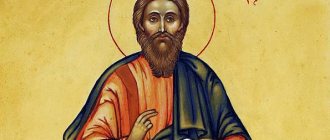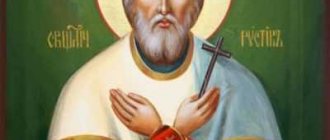| Apostle Bartholomew |
Bartholomew
(Aram. בר תלמי, Greek Βαρθολομαῖος; c.), apostle from 12 June 11 - repose, August 25 - transfer of relics to the island of Lipari and in the Cathedral of the Twelve Apostles
In the New Testament, Bartholomew is mentioned only in four lists of the 12 disciples of Jesus Christ (Mt 10:3; Mk 3:18; Lk 6:14; Acts 1:13). “Bartholomew” is probably a common Aramaic patronymic name (patronymic) - “son of Thalmai” (cf. Joshua 15:14), or “son of Tolomei” [1].
The identification of Bartholomew with the apostle, which has become traditional. Nathanael (John 1:45-51) is argued by the Bollandists [2], referring to the fathers and teachers of the Church, although, for example, Blessed. Augustine opposed their identification [3].
The apostles Bartholomew and Nathanael are identified based on the fact that the name Bartholomew is given in the lists of apostles in the Synoptic Gospels, while the Evangelist John the Theologian classifies Nathanael as an apostle, whom the Synoptic Gospels do not mention. In the Gospel lists of the apostles, where the names are given in pairs, Bartholomew stands next to the apostle. Philip, which allows us to make an assumption about the connection between these apostles (cf. John 1:43-48). In the Evangelist John, it is Philip who informs Nathanael about Jesus; Nathanael's apostolic status is obvious in the story of the miraculous catch of fish on Lake Tiberias, since all the other disciples who witnessed this miracle are apostles (John 21: 1-14). Finally, since Bartholomew is the patronomic name of the apostle, it is conceivable that he could have had another name, Nathanael (Aram. Nathanael
), then the full Aramaic name of Bartholomew is
Nathanael bar Tolami
.
| Ap. Bartholomew. Fresco from the Stavronikita Monastery on Mount Athos. 1546 Icon painters Theophanes of Crete and Simeon |
Byzantine hagiographical tradition or considered ap.
Nathanael as a separate person [4], or identified him with St. Simon the Zealot [5]. Byzantine tradition identifying ap. Nathanael with ap. Simon, is reflected in the liturgical books of the Greek Churches [6]. In the latest works, Greek hagiographers either tend to identify the apostles Bartholomew and Nathanael [7], or give both versions: identifying Nathanael with Bartholomew and with Simon the Zealot [8]. The Russian Church in the 19th century still certainly followed the Greek tradition [9], but already with the publication of “The Lives of the Saints, set out according to the guidance of the Four Menaions of St. Demetrius of Rostov...” [10] their commentator sees in Nathanael the same person as Bartholomew, although he also mentions other opinions (identifying Nathanael with Simon the Zealot or with one of the 70 apostles) [11]. The Holy Scriptures do not say anything definite about the life of the Apostle Bartholomew, unlike Nathanael (see).
According to the apocryphal “Acts of the Apostle Thomas,” Bartholomew was among the 11 apostles who cast lots and each received their own lot for missionary preaching [12]. He preached in Asia Minor (together with the Apostle Philip - in Phrygia and Lycaonia), Mesopotamia, Parthia (Persia) and India (“Martyrdom of the Apostle Bartholomew”), by which some authors meant Ethiopia (Rufinus of Aquileia, Socrates Scholasticus), and others — Arabia Happy [13]. However, in the writings of Eusebius of Caesarea [14] and Bl. Jerome [15] we are talking specifically about India, where Bartholomew left the Gospel of Matthew in Hebrew (or translated into Indian [16]), found by the Christian philosopher Panten, a teacher at the Alexandrian Catechetical School.
In “Acts of St. Andrew" tells about Bartholomew's missionary journey along the Black Sea coast. From “India” he went to Parthia, then to Greater Armenia. On Artashat Hill he met with the Apostle Judas Thaddeus [17].
Bartholomew converted the sister of the Armenian king Vogukha and many nobles to Christianity; By order of King Sanatruk (Astyages), he was crucified upside down, skinned alive and beheaded.
Biography of the Apostle Bartholomew
Information about the life of Bartholomew is known from apocryphal sources. His name is mentioned among the 12 disciples of Christ in the Gospels of Luke, Matthew, and Mark. John in the Gospel reports that the fourth Christ called Nathanael as a disciple. Theological scholars have come to the conclusion that Bartholomew is more of a patronymic (translated from Aramaic as “son of Falmai”). That is, the names Nathanael and Bartholomew, mentioned in the New Testament texts, refer to the same person.
Nathanael was born in the 1st century BC in Cana (Galilee). Philip led him to Christ. A close friend and relative told Bartholomew that he had met the messiah that Moses and the prophets were expecting. Nathanael doubted that anything “good” would emerge from Nazareth, because Galilee had always been a land of atheists and sinners.
Jesus accepted Bartholomew as one of his disciples, having gotten to know him better, he considered him honest and simple-minded, a true Jew. Holy Scripture does not contain information about the life of the apostle, he is only indicated there.
When Christ left the disciples, Bartholomew, together with Philip, were called to preach the Gospel in the lands of Asia Minor.
On the road they were accompanied by Philip's sister, the maiden Mariamne. They walked together, explained the Word of God to people, sometimes their paths diverged for a short time. The pagans did not want to hear about the appearance of Christ; the preachers were persecuted, put in prison, and expelled from the cities. But the Lord supported the apostles, by His grace they performed miracles that helped people believe.
In one of the cities where the pagans worshiped a large viper, the apostles destroyed the monster and immediately gained many supporters who believed in Christ.
Tradition has preserved information about the miracles performed by the apostles by the grace of God in the city of Hierapolis. The saints came to the city preaching, attracted the hearts of the pagans with stories about Christ, and healed the sick. Philip and Bartholomew restored sight to Stachy, who had been blind for 40 years. After this miracle, the man was baptized and believed in God.
The pagans rushed to the apostles for healing, praised the merciful God, and were baptized. Rumors that faith in the pagan gods had been shaken reached the city authorities. The apostles were captured, put in prison, and accused of undermining the foundations of the country. The dark pagans suspected witchcraft and believed that the power of the preachers was hidden in their clothes.
The saints were ordered to undress. Mariamne suddenly found herself enveloped in flames; no one was able to touch the maiden. Philip and Bartholomew were crucified on crosses. The wrath of God overtook the pagans - an earthquake began during the judgment. The ruler, guards, judges and the most curious townspeople disappeared and fell into the ground.
The apostles were removed from the crosses, but Philip had already died. Leaving Hierapolis, Bartholomew ordained Stachys to the rank of bishop and ordered him to carry the Word of God. After Hierapolis, Nathanael and Mariamne parted ways. The apostle went to preach in India, sister Philippa went to Lycaonia, where she soon died.
Martyrdom and death
In India, Bartholomew continued his sermons. To make the Word of God understandable to people, the apostle translated the Gospel of Matthew from the Jewish language into the local language. Having reached Greater Armenia, Nathanael continued to convert pagans, performed miracles, and healed. The saint cast out demons from the Armenian princess, for which the ruler Polymius wished to thank Bartholomew with rich gifts.
But the preacher refused the king’s generosity, saying that he only wanted the salvation of human souls. Having learned that Christ gives great power to his disciple, the king and his family and many other people believed in God. Nathanael baptized Armenians in many cities of the kingdom.
Losing their flock, the pagan priests turned to brother Polymius for help. Astyages ordered the capture of the apostle (according to most sources, in the city of Alban, modern Baku). Nathanael was crucified upside down, then skinned alive and beheaded. Christians collected the remains of the saint in a tin shrine and buried them with honor.
BARTHOLOMEW
Service June 11. In the Typikon of the Great Church. IX-X centuries V.'s memory is given along with the memory of Ap. Barnabas, the service at the liturgy was written out (common to the apostles, Gospel reading - Lk 9. 1-10. 1. 16-21, involved Ps 32.1). According to the manuscript Hieros S. Crucis gr. 40, 10th century, on Ps 50 the troparion of the 3rd tone is sung “᾿Απόστολοι ἔνδοξοι, πρεσβεύσατε τῷ ἐλεήμονι Θεῷ ἵνα πταισμάτων [ἄφεσιν παράσχῃ ταῖς ψυχαῖς ἡμῶν]" ( ) (Dmitrievsky. Description. T. 1. P. 80; Mateos . Typicon. T. 1. P. 310, 312).
According to all editions of the Studio Charter, on the day of memory of V. and Barnabas, a festive service is performed with “God is the Lord.” In the Studios-Alexievsky Typikon of 1034 (GIM. Syn. 330. L. 169 vol. - 170) the memory of the apostles is celebrated with a rest from work. According to the Evergetid Typikon con. XI century (Dmitrievsky. Description. T. 1. P. 459-460) and the Messinian Typikon of 1131 (Arranz. Typicon. P. 157-158) the evening kathisma is abolished, in addition, according to the Messinian Typikon, kathismas at matins are replaced with special holiday antiphons .
In worship according to the Jerusalem Rule, there was a gradual increase in the degree of festivity in following the apostles. In the first printed Moscow Typikon of 1610, it is indicated to perform the sixfold service (see Art. Signs of the holidays of the month); in the Typikon of 1633 there is no sign, the service is described briefly. According to the Official of the Moscow Assumption Cathedral of 1633, the festive service was also not performed: “Evening and morning the good news is announced at the swan, ringing two bells, they sing according to the charter” (Golubtsov A.P. Officials of the Moscow Assumption Cathedral and the exits of Patriarch Nikon. M., 1908. P. 56). In the Typikon of 1695 there is a service with a great doxology, stichera on the verse and sedals of the apostles. In modern Greek The minor sequence is practically the same (only the sedals after the kathismas at Matins of Octoechos). According to the decree of St. Synod of September 20, 1722, each apostle from 12 must have a polyeleos service (Bulgakov S.V. Handbook for priests and clergy. M., 1993. [Vol. 1.] P. 242), which was enshrined in subsequent editions of the Typikon, including the one currently used in the Russian Orthodox Church.
Only the basis (troparion, canon and some stichera) is modern. the corpus of V. chants goes back to the liturgical books of the period of the Studite Charter; they did not contain chants dedicated to both apostles; such chants, as a rule, were included in the successions no earlier than the 17th century. General troparion 3rd tone ""; kontakion of the 4th voice, similar to “Thou art appeared”: “”; canon of the 2nd tone, the work of Theophanes (according to the Greek Menaion and the Evergetid Typikon), irmos: “᾿Εν βυθῷ κατέστρωσε ποτὲ” ( ), beg. "῾Ο προγνώστης πάντων καὶ Θεός, τὸ τῆς διανοίας σου, θεοειδὲς καθορ ῶν ἐξελέξατο" ( ); V.'s canon is connected with the canon of the Ap. Barnabas: they have the same irmos, in Greek. Only the canon of Barnabas has a Menaion of the Theotokos (as in the Russian Menaion under Dec. 4), in the studio Menaions the canons are placed separately, The Theotokos in cantos 6, 8 and 9 coincide (for example, in the Menaion of the Russian National Library. F. p. I. 36 , XI century); There are no self-agreed V., only 1 is self-agreed, in which both apostles are glorified (the other self-agreed in the service is Barnabas); One group of 3 similar stichera is dedicated to V.; in the other 2 groups of stichera, both apostles are glorified. The sedals are taken from the General Menaion. In Greek Mena there are 2 other samoglas, dedicated to the apostles V. and Barnabas.
The canon of V. of the 4th plagal, i.e., the 8th, tone, the creation of Joseph, with the acrostic poem is also known from manuscripts: “῾Υμνῶ γεγηθὼς τὸν καλόν μοι προστάτην. ᾿Ιωσήφ" (I sing with the joy of my good representative. Joseph), irmos: "῾Υγρὰν διοδεύσας ὡσεὶ ξηρὰν" ( ), beginning: "῾Υπέρφωτος ἥ λιος γεγονὼς νώσει τοῦ Λόγου" (Bright Sun, born of the union of the Word) (Ταμεῖον. Σ 214). The acrostic of this canon almost coincides with the acrostic of V.’s canon for August 25.
Apostolic reading at the liturgy - Acts 11. 19-26, 29-30 (chosen in connection with the mention of the apostle Barnabas); Gospel reading is general. In Greek Mena indicates another apostolic reading - 1 Cor 4.9-16 (general reading to the apostles).
Apostles Bartholomew and Simon. Cloisonne enamel. Fragment of the Khakhul triptych. X century (State Museum of Art of Georgia. Tbilisi) Apostles Bartholomew and Simon. Cloisonne enamel. Fragment of the Khakhul triptych. X century (State Museum of Art of Georgia. Tbilisi) Service August 25. In the Typikon of the Great Church. IX-X centuries V.'s memory was noted along with the memory of Ap. Titus, liturgical instructions refer to other commemorations of this day (Mateos. Typicon. T. 1. P. 382-383). In the Studi Typikons, the service with “God is Lord” is prescribed, but unlike the Typikon of the Great Ts. in the Studiysko-Alexievsky (Pentkovsky. Typikon. P. 365), Evergetidsky (Dmitrievsky. Description. T. 1. P. 494) and Messinian (Arranz. Typicon. P. 182) Typikons, as well as in the Studian Minaions (Gorsky, Nevostruev .Description.T. 6. P. 76) in memory of V. and Titus are separated: August 25 - memory of the ap. Titus, and on August 24 - the transfer of the relics of V. In the Typikon of George Mtatsmindeli of the 11th century. (Kekelidze. Liturgical cargo monuments. P. 271) the commemoration of the transfer of V.’s relics falls on August 25. in connection with the app service. Tita.
In the oldest Jerusalem Typicons (for example, Sinait. gr. 1096, 11th century - Dmitrievsky. Description. T. 3. P. 55) V.’s memory is also celebrated on August 24. (August 25 - Apostle Titus). Afterwards Memory of V. and Titus begin to be celebrated on the same day - August 25. According to the service description Aug 25 according to the first printed Greek. and glory Typicons, the following to the apostles almost did not contain common hymns, just like the following to V. and Barnabas on June 11. Only the troparion and the luminary were common. In the same way, the successions of the saints are presented in modern times. rus. Minee. The service does not have a holiday sign. In Greek In practice, the status of this day has changed over time, so that in modern times. Greek Mena is given a doxological service. Thus, service 25 Aug. almost completely similar to the June 11 service; The only difference is that on Aug. 25. At the evening stichera, the stichera of the Octoechos are sung. Although general hymns to the apostles did not appear in the service, as on June 11, both apostles are glorified alternately at the praises within the same group of stichera.
General troparion: ""; Kontakion V. is the same as on June 11, with some textual differences: “”; canon of the 4th tone, the creation of Joseph, with the acrostic: “̀λδβλθυοτεΥμνοις γεραίρω τὸν καλόν μου προστάτην” ( ), irmos: “᾿ "" ( ); 1 is self-agreeable and 3 is similar. In Greek Menaeus is self-according, sedal and others are luminous, and there are also stichera on the praises of both apostles.
According to manuscripts for August 25. another canon of V. is known - the 4th tone, with the 2nd song, the creation of Joseph, an acrostic: “Τοὺς σοὺς ὑφαίνω, Βαρθολομαῖε, κρότους. ᾿Ιωσήφ" (For you, Bartholomew, applause. Joseph), irmos: "῾Ο πατάξας Αἴγυπτον" ( ), beginning: "Τὴν τοῦ λόγου σάλπι γγα, τὸν οὐρανὸν τὸν ἔμψυχον" (Words trumpet, animate sky) (Ταμεῖον. Σ. 272-273).
The service at the liturgy is mainly common to the apostles, except for the apostolic reading - Titus 1. 1-4, 2. 15-3. 3, 12-13, 15 (selected from the message of that apostle, whose memory is celebrated); Gospel reading - Matthew 5. 14-19.
A. A. Lukashevich
Meaning in Orthodoxy
Orthodox Christians revere Bartholomew for preaching the Word of God and spreading the Christian faith. Jesus loved his disciple and valued him for his simplicity and directness. All his life the apostle endured persecution and reproach, but, faithful to the covenant, he walked the earth so that Christian teaching would spread among the pagans. Nathanael himself baptized many people, explained the Scriptures, and translated the Gospel.
Information: special veneration for the disciple of Christ developed in Armenia, where he brought Christianity.
Reverence
Apostle Bartholomew is honored as one of the disciples of Christ, chosen by Him to carry the Word of God. Jesus saw in Nathanael the integrity, the absence of guile. Nathanael's apostolic preaching led to the conversion of pagans; in the lands through which the saint walked, many people became Christians.
Days of veneration of the Apostle in Russia:
- 5 May;
- June 24 – day of death;
- July 13 – the day of the Council of the Twelve Apostles;
- September 7 is the day of the transfer of holy relics.
Apostle Bartholomew is considered the patron saint of Armenia.
Literature
- Budge EAW The Contendings of the Apostles. L., 1901;
- Schermann T. Prophetarum vitae fabulosae indices apostolorum discipulorumque Domini Dorotheo, Epiphanio, Hippolyto aliisque vindicate. Lpz., 1907. S. 110;
- Quasten. Patrology. Vol. 1. P. 127;
- Brownrigg R. The Twelve Apostles. NY, 1974;
- Leidig E. Natanael, ein Sohn des Tholomäus // Theologische Zeitschrift. 1980. Bd. 36. S. 374-375;
- Esbroeck M., van. The Rise of St. Bartholomew's Cult on Armenia // Medieval Armenian Culture. Chico (Calif.). 1984. P. 161-178;
- Dolbeau F. Une liste latine de disciples et d'apôtres traduite sur la recension grecque du Pseudo-Dorothée // AnBoll. 1990. T. 108. Fasc. 1-2. P. 51-70;
- NTApo. Tüb., 1991-19926. Bd. 1. S. 424-440;
- Bd. 2. S. 404-408.
- “The life and works of the holy, glorious and all-praised twelve apostles of the Lord, the seventy lesser apostles and other equal evangelists of Christ.” 7. St. Apostle Bartholomew. – K.: Printing house of the Kiev-Pechersk Lavra, 2012.
- Saint Demetrius of Rostov. “Lives of the Saints. June". The Life and Sufferings of the Holy Apostle Bartholomew. Memory of June 11. Publication of the Holy Vvedenskaya Optina Hermitage. 1997.
- Basilica di San Bartolomeo Apostolo. Benevento - part 2. Cathedral and Basilica of San Bartolomeo.
Iconography
On the icons, Nathanael is painted in clothes traditional to ancient times. Hair and beard are often black (sometimes gray) and characterize middle age. The apostle's hands are raised for blessing; in many icons Bartholomew holds a scroll with a sermon.
In many ancient churches (Ravenna 5-6th century) early images of Bartholomew were preserved on church utensils, icons, the altar, and in the nave. The Apostle is written together with other disciples of the Savior, Nathanael is included in group scenes illustrating the events of the Gospel, next to Christ and the Mother of God.
The face of Bartholomew can be seen on liturgical vessels, icon frames, and on reliquaries in which the relics of the saint are kept. In Russia, frescoes from the 12th century have been preserved in a church in Vladimir. There are many ancient images of Nathanael in the Caucasus.
In the traditions of the Western Church, Nathanael is painted on icons with a knife in his hands, bleeding after torture, covered like a cloak with his own skin.
Orthodox icon painters depict the martyrdom of Bartholomew in the form of a crucifixion, in some images - upside down.
Are Apostle Bartholomew and Apostle Nathanael the same person?
Nathanael is not mentioned in the Synoptic Gospels or the Acts of the Apostles. But along with Philip, Matthew, Mark and Luke feature the Apostle Bartholomew, whom John does not name. On this matter, in church tradition today there is a consensus that Saint Bartholomew and Nathanael are one and the same person (although, according to some teachers of the Church, both in the Byzantine tradition and in the ancient Russian one they were not identified).
The use of different names should not cause confusion, since such discrepancies occur many times in the Gospels. Experts in ancient languages even reveal the meaning of the name Bartholomew as the son (“bar”) of Falmai (a name found in the Bible). That is, the name Bartholomew is more of a patronymic, a patronymic. But it is under this name that the apostle is further mentioned in various apocrypha and sacred tradition.
Location of the relics
The relics of the saint buried in Alban showed many miracles. Pilgrims began to flock to the saint’s grave. At the beginning of the 6th century, the reliquary was moved to the city of Dara. When the city was captured by the Persians, Christians tried to hide the shrine, but they were driven to the shore of the Black Sea.
Then desperate people lowered the ark into the sea, and it floated. Together with the relics of Bartholomew, the reliquaries with the relics of other saints miraculously reached the islands of Lipara by sea. Bishop Agathon came to the shore of Lipara and had a vision. The Holy Father transferred the relics to the Church of God.
In the 9th century, the relics were transported to the church of a small town near Naples; in the 10th century, the relics were sent with honor to Rome.
You can venerate the relics of the holy apostle:
- Temple of San Bartolomeo, Tiberina Island, Rome;
- Cathedral of the Myrrh-Bearing Women, Baku;
- Church of Athos.
Thousands of Christians flock to the relics of Christ’s disciple to receive God’s grace and make requests and prayers.
When is the day of remembrance of the Apostle Bartholomew (Nathanael) in 2022?
The Day of Remembrance of St. Bartholomew the Apostle will be celebrated three times in 2022.
- May 5
is the day of remembrance of the Apostle Bartholomew. - June 24
is the day of the death of the Apostle Bartholomew. - September 7
– transfer of the relics of the Apostle Bartholomew.
According to the old style, the day of remembrance of the Apostle Bartholomew was celebrated on the church calendar on April 22, the day of his death was June 11. The transfer of the relics of the Apostle Bartholomew according to the old style is celebrated on the church calendar on August 26. The dates are not moving; they are celebrated by the Orthodox Church on the same day every year.
Apostle Bartholomew is identified with Apostle Nathanael. Evangelists Luke, Matthew and Mark, listing the names of the twelve disciples of Jesus, name Bartholomew. When listing the apostles in pairs, Bartholomew is named together with Philip. However, John the Theologian speaks of a certain Nathanael, to whom Philip informs about the Messiah. In this regard, church tradition identifies Nathanael with the Apostle Bartholomew.
Prayer to the Holy Apostle Bartholomew
O glorious Apostle of Christ Bartholomew, who gave up his soul for Christ and fertilized His pasture with your blood! Hear your children's prayers and sighs, now offered by your brokenhearted hearts. We are therefore darkened by lawlessness, and for this reason we are covered with troubles, like clouds, but the oil of the good life is greatly impoverished, and we are not able to resist the predatory wolf, who boldly strives to plunder the heritage of God. Oh, strong! Bear our infirmities, do not separate from us in spirit, so that we may not be separated in the end from the love of God, but protect us with your strong intercession, may the Lord have mercy on all of us for your prayers for the sake of, may He destroy the handwriting of our immeasurable sins, and may He be honored with all the Saints of the blessed The kingdom and marriage of His Lamb, to Him be honor and glory, and thanksgiving and worship forever and ever. Amen.
Bartholomew was chosen by Jesus to preach God's commandments and bring people the light of the Christian faith. The disciple of Christ honestly and worthily fulfilled his duty - he converted the pagans, helped the needy, healed the sick, accepted martyrdom, without giving up preaching.
Links
- Dimitry Rostovsky. The Life and Sufferings of the Holy Apostle Bartholomew
Divine service Armenian rite • Matah Personalities Gregory the Illuminator and the founders of the Armenian Church, the apostles Thaddeus
and BartholomewLists Churches and monasteries • Patriarchs • Dioceses • Saints Other Catholicos of All Armenians • Ashtishat Cathedral • Armenian Church Calendar • Vardapet
